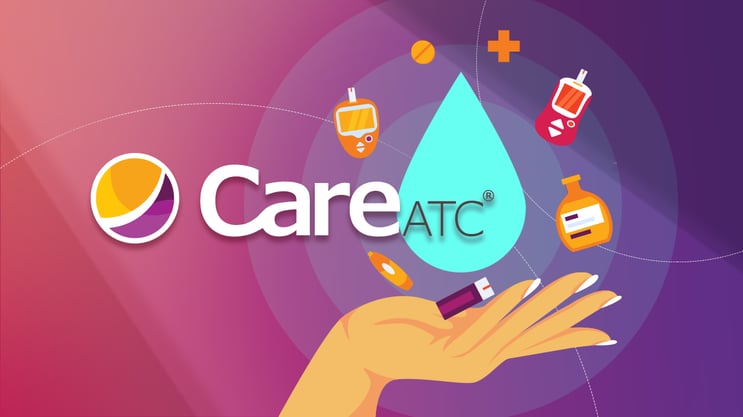 Prediabetes, a condition characterized by elevated blood sugar, is a precursor to diabetes. It affects 1 in 3 Americans, and more than 84% of those affected are unaware that they have the condition. (1) If gone undetected, prediabetes can progress to type 2 diabetes and lead to many health complications in the body, affecting the heart, kidneys and blood vessels.
Prediabetes, a condition characterized by elevated blood sugar, is a precursor to diabetes. It affects 1 in 3 Americans, and more than 84% of those affected are unaware that they have the condition. (1) If gone undetected, prediabetes can progress to type 2 diabetes and lead to many health complications in the body, affecting the heart, kidneys and blood vessels.
The good news about type 2 diabetes is that in many cases, it is preventable! Lifestyle changes can significantly reduce or eliminate your risk.
Let’s take a closer look at what is happening inside the body when someone has prediabetes. Insulin, a hormone that is made by the pancreas, escorts sugar into the cells so that it can be used for energy. In the bloodstream, sugar is called “glucose.” Think about insulin like a key, that “unlocks” the cell which allows the glucose in. In prediabetes, the cells do not respond normally to insulin. It’s as if the cells have changed the lock, and the insulin can no longer get the glucose where it needs to go. Glucose instead hangs out in the bloodstream. The pancreas gets a signal that glucose levels are higher than they should be and in turn, pushes out more insulin to help lower it. Over time the pancreas can’t keep up, and blood sugar levels worsen, leading to type 2 diabetes.
But fear not. Diabetes does not have to be your destiny! You have the power to arrest this process and get those blood sugar levels under control. Here are 4 key things you can do to reduce your risk:
1) Know Your ABC’s.
Here’s a quick breakdown of the ABC’s: A stands for Hemoglobin A1C, B for blood pressure, and C for Cholesterol. Hemoglobin A1C tells you whether blood sugar levels have been elevated over the last 3 months. The goal is to have this number below 5.7%. Blood pressure should ideally be <120/80 and your cholesterol ratio < 3.5. Prediabetes and diabetes can increase your risk for heart disease so knowing these numbers is important. This information can inspire you to steer the ship in the other direction. Be sure to get regular, annual checkups with your doctor or, if you have access to a worksite health assessment, be sure to participate to get that vital (and in some cases, lifesaving) information.
2) Get Moving!
When it comes to diabetes prevention, exercise is quite possibly the best medicine. Because your cells need sugar to sustain activity, exercise forces the cells to be more sensitive to insulin. The benefits of being active go way beyond blood sugar control, too – exercise is good for just about every cell and organ in your body. Aim for at least 30 minutes of moderate activity, like walking, swimming or biking, at least five days per week. If you engage in more vigorous activity like running, you can meet the activity goal in 20 minutes, three days per week. Start small, find an activity you enjoy, get a workout buddy, and most importantly, budget the time for it. Even if you can’t hit these recommended targets, some activity is better than none, so do what you can!
3) Lose Weight.
Excess body weight can cause insulin resistance. In fact, it’s estimated that 85% of people living with type 2 diabetes are overweight or obese. (2) Losing weight can make a big difference, and a little bit of weight loss goes a long way. Studies show that even a modest amount of weight loss (5-7% of your body weight) can reduce the risk of diabetes by 58%!
4) Use Carbohydrate Common Sense.
Eating right is a very effective way to reduce your diabetes risk. Because carbohydrates impact blood sugar levels, many assume avoiding carbs is the way to go. The problem with this oversimplified approach is that w hole, unprocessed forms of carbohydrate such as vegetables, fruits, beans, and whole grains are foods that provide nutrients, fiber and health benefits in the prevention and treatment of diseases like diabetes. (5) Swearing off carbohydrates and loading up solely on high fat, high protein foods is not a recipe for health improvement, and may actually contribute to insulin resistance and increase the risk for heart disease. So in short: slash the “simple” carbohydrates like processed grains and sugar, but the whole, fiber-and-nutrient-rich carbohydrates listed above should still have a place at the table.
|
If you can’t remember the last time you had a health checkup, it’s probably the right time to do so. |
References
- https://www.cdc.gov/diabetes/basics/quick-facts.html
- https://www.ncbi.nlm.nih.gov/pmc/articles/PMC4887150/#__ffn_sectitle
- https://www.hopkinsmedicine.org/endoscopic-weight-loss-program/conditions/diabetes.html
- https://www.cdc.gov/diabetes/managing/active.html
- https://jamanetwork.com/journals/jamainternalmedicine/fullarticle/2738784

 Posted by
Posted by


